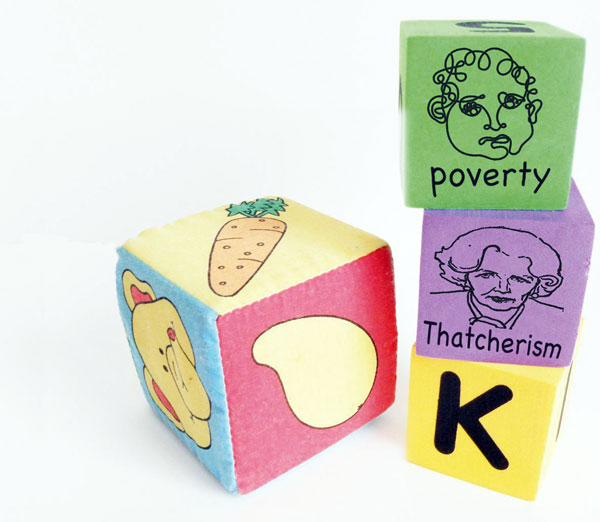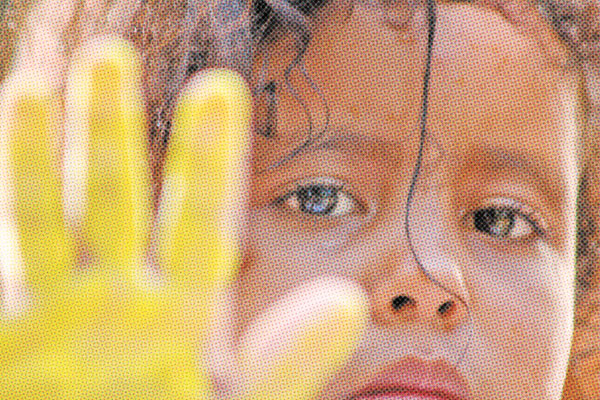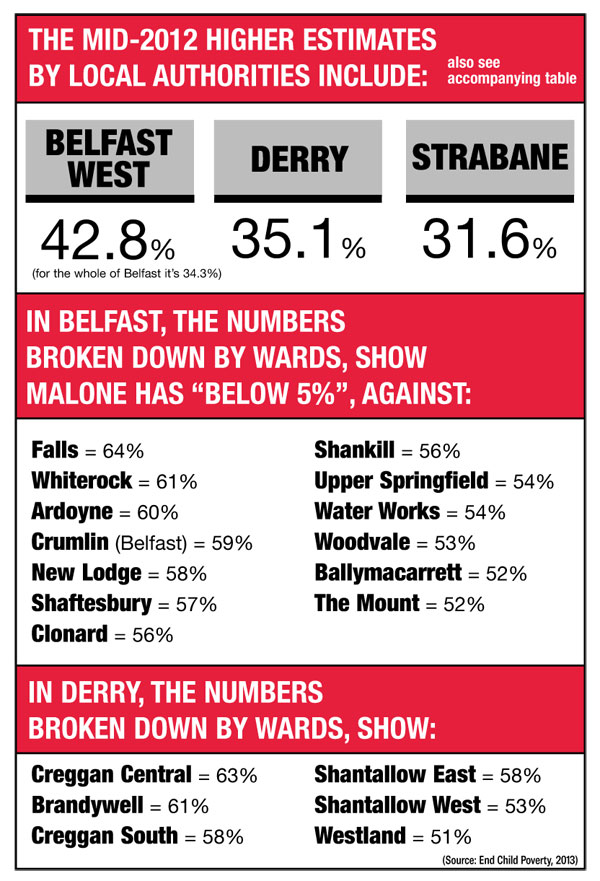28 April 2013 Edition
Thatcher is dead but Thatcherism alive and well
Poverty figures for Six Counties show bankruptcy of Tory austerity policies

Lynda Wilson of Barnardo’s said the figures were ‘shocking’ and they show that over 100,000 of the North’s children live in poverty
THE British Government’s Work and Pensions Minister, Iain Duncan Smith, speaking on BBC’s Radio 4 in defence of the Tory/Liberal Democrat welfare cuts claimed he could live on £53 a week.
Given that it was April Fools’ Day, 1 April, listeners might have been forgiven for thinking it was a joke.
The reaction to Duncan Smith’s glib remark was almost half a million people signing a petition challenging the Tory millionaire, who lives in a mortgage-free house valued at £2million, to prove his boast.
It will come as no surprise that the man whose weekly salary is over £1,500 refused to meet the public challenge and show us just how you do live on £53 a week. He chickened out.
Nor will it surprise anyone that the man who is spearheading the Tory blitz on the working class will ignore the effects of these cuts on the most vulnerable as these cuts stem from the Thatcherite ideology that favoured the rich and powerful at the expense of the less-well-off.
In the North, where Sinn Féin is leading the campaign in Stormont to resist the British Government’s cuts agenda, recent figures published by the End Child Poverty campaign reveal that west Belfast has child poverty levels of 43%, second only to Manchester Central, which tops the list of 650 Westminster constituencies. Derry with 35% — one in three children living in poverty — comes in at number 5 on the list of Westminster constituencies.
Lynda Wilson of the children’s charity Barnardo’s, one of 100 charities involved in the End Child Poverty campaign, described the figures as, “shocking”, adding that they show that over 100,000 of the North’s children live in poverty. She said:
“Behind these statistics sit the most vulnerable children in society whose life chances risk being compromised by our failure to tackle child poverty effectively.
“Barnardo’s works day in and day out with families in the most deprived areas. The grim reality is that many families face vicious cycles of debt and impossible choices between heating homes or cooking hot meals for their children.
“We know that children growing up in low-income households are more likely to suffer from chronic illness, do less well in education and struggle to find work on leaving school.”

• Children in low-income households are more likely to do less well in education and struggle to find work after leaving school
Speaking in November of last year at a conference on ‘Combating Child Poverty’, organised by Sinn Féin MEP Martina Anderson, Michelle Murphy of Social Justice Ireland highlighted the issue of “working poor” and pointed out that 165,000 people in the Six Counties were classified as working poor, an increase of 30,000 since 2004/5.
She called for “a new system to put a ‘social floor’ under people and to ensure that all members of society have sufficient income to live life with dignity and are included in the benefits of sustainable economic development”.
In 2011, a report by Queen’s University academics Mike Tomlinson and Grace Kelly looked at the likely impact of the British Government’s spending review on living standards in the North, especially the living standards of those with the lowest incomes.
They wrote that cuts in Westminster Treasury funding for the North would be greater than many assume:
“The consequence of the Spending Review is that by 2014-15 Northern Ireland will be receiving 7.6% less in real terms from the British Treasury than it was in 2010-11.
“The Treasury will have cut £530million from the annual capital budget by 2014-15 and £780million from current funding.”
The findings report that “by 2014-15, the Treasury will have withdrawn aggregate funding of £3.48billion, which is more than this year’s current expenditure on Education and Justice”.
At the conference on ‘Combating Child Poverty’ organised by Sinn Féin MEP Martina Anderson, Michelle Murphy of Social Justice Ireland pointed out that 165,000 people in the Six Counties were classified as ‘working poor’ an increase of 30,000 since 2004/5
The research also raises the fear that these figures may be an under-estimate.
The report also gauges that there will be a shortfall of £4.5billion (in cash terms) by 2018. This will seriously undermine the explicit objectives of the strategy, including economic stability, tackling areas of social disadvantage, addressing poverty and promoting tolerance, inclusion, equality and good relations.
The justification for the austerity policies of both the Westminster and Dublin governments is that ‘we’ are living beyond our means, that the deficit must be reduced by any means. But the working class, and increasingly the lower middle class, have ended up subsidising the repayments to the IMF and the ECB.
The con trick that both the Leinster House and Westminster governments have used to try to justify their bail-out strategies is that there is no money. Yet the wealth of the British and Irish economies is still controlled by the privileged few and used to serve their own interests.
The combined wealth of the richest people in Britain and Ireland was, according to figures published by The Sunday Times, £414billion.
Clearly austerity is about robbing the poor to ensure the rich get richer and the Tory ideology of both the London and Dublin governments as promoted through the mainstream media, economists and social commentators provides the rationale for their attacks on the less-well-off.
Our task as republicans is to fulfil the Democratic Programme of the First Dáil and claim “all its [the nation’s] material possessions, the nation’s soil and all its resources, all the wealth and all the wealth-producing processes within the nation . . . and reaffirm that all right to private property must be subordinated to the public right and welfare”.

Percentage of children in poverty
By local authorities and wards
% by area
- Antrim 14.4
- Ards 15.2
- Armagh 16.4
- Ballymena 16.4
- Ballymoney 20.0
- Banbridge 13.9
- Belfast (all) 34.3
- Belfast (West only) 42.8
- Carrickfergus 15.8
- Castlereagh 12.7
- Coleraine 20.8
- Cookstown 20.2
- Craigavon 20.7
- Derry 35.1
- Down 19.5
- Dungannon 19.1
- Fermanagh 19.1
- Larne 16.7
- Limavady 26.1
- Lisburn 20.9
- Magherafelt 16.9
- Moyle 23.4
- Newry & Mourne 24.6
- Newtownabbey 16.6
- North Down 12.8
- Omagh 21.7
- Strabane 31.6
(Source: End Child Poverty, 2013)

In Belfast, the numbers broken down by wards, show Malone has “below 5%”, against:
- Falls = 64%
- Whiterock = 61%
- Ardoyne = 60%
- Crumlin (Belfast) = 59%
- New Lodge = 58%
- Shaftesbury = 57%
- Clonard = 56%
- Shankill = 56%
- Upper Springfield = 54%
- Water Works = 54%
- Woodvale = 53%
- Ballymacarrett = 52%
- The Mount = 52%
In Derry, the numbers broken down by wards, show:
- Creggan Central = 63%
- Brandywell = 61%
- Creggan South = 58%
- Shantallow East = 58%
- Shantallow West = 53%
- Westland = 51%
(Source: End Child Poverty, 2013)
• mid-2012 estimates




